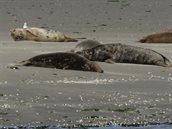Refining models for sound exposure in marine mammals
The main ecological concern below the surface is underwater sound. High levels of noise are produced during the piling of foundations for wind turbines in particular. Animals may be harmed as a result, or at least disturbed, with marine mammals being thought to be the most vulnerable. In the Dutch section of the North Sea, there is most concern about the harbour porpoise, harbour seal and grey seal. Accurate models are essential to determine how these animals are affected by noise from wind farm construction from activities like pile-driving or shipping movements.
 In the Dutch section of the North Sea, there is most concern about the harbour porpoise, harbour seal and grey seal. Accurate models are essential to determine how these animals are affected by noise from wind farm construction from activities like pile-driving or shipping movements.
In the Dutch section of the North Sea, there is most concern about the harbour porpoise, harbour seal and grey seal. Accurate models are essential to determine how these animals are affected by noise from wind farm construction from activities like pile-driving or shipping movements.
The current models used to predict noise propagation and the effect on marine mammals assume that harbour porpoises are more sensitive to underwater noise than seals. In other words, noise appears to disturb porpoises sooner than other animals. An associated assumption is that measures taken to mitigate these effects on porpoises will automatically prevent significant effects on harbour seals (and also grey seals since the hearing of these seal species seems to be similar). Nevertheless, no distinction is made between different noise levels and different indicators of disturbance such as leaving the area, ceasing to feed or to communicate, and signs of stress.

Resting seals (photography: Aylin Erkman)
However, in 2016, the validation of the sound propagation model demonstrated that the lower-frequency components of sound travel further than expected. In combination with the fact that seals can hear better at lower frequencies than porpoises, this led TNO to investigate whether it is correct to assume that harbour porpoises are more sensitive to disturbance by underwater noise than seals if the entire spectrum of piling noise is taken into consideration.
The initial conclusions of the study were that modelling for temporal and permanent hearing injury should include frequency weighting to calculate unmitigated effect distances. It is not yet possible to determine a frequency weighting for disturbance effects because adequate empirical data are still lacking. We are now working with BSH in Germany to see if their data can be used to remedy this difficulty. Nonetheless, until adequate data are available (from Germany or another source), it will remain unclear whether it is correct to assume that the harbour porpoise is the most sensitive species.